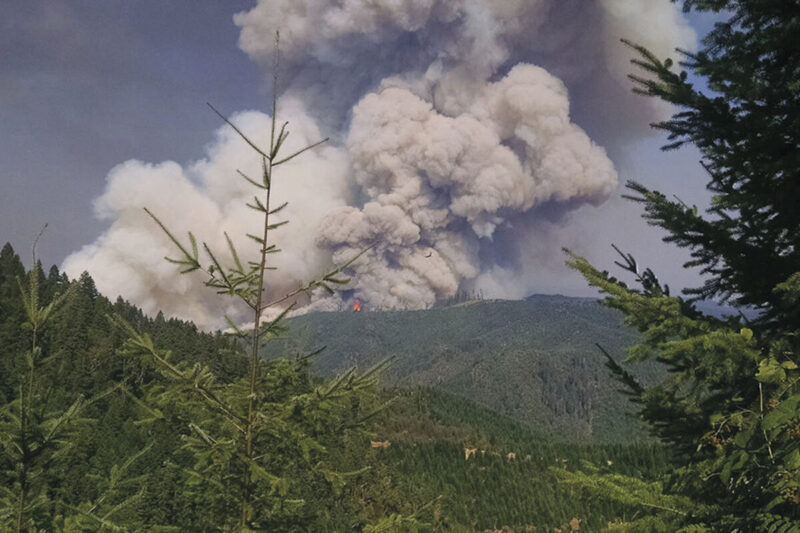Sean C. Morgan
While rain is in the forecast through next week, fire season is fast approaching; and the Oregon Department of Forestry is reminding people that it’s time to prepare.
That means cleaning vegetation from around homes and clearing brush away from driveways to allow access for emergency vehicles, said Chad Calderwood, forest protection supervisor with the Oregon Department of Forestry Sweet Home Unit.
“Cleaning up around the home is an excellent way to start thinking about fire prevention this summer,” says ODF Fire Prevention Coordinator Tom Fields. “Whether it’s disposing of the yard waste created through cleanup, planning your summer camping trip, or using outdoor power equipment, be sure and exercise caution with fire or spark emitting activities.”
They aren’t the only ones concerned.
On Monday, May 11, a number of private timberland owners and managers in Western Oregon announced they were closing their lands to public access due to dry conditions and complications posed by coronavirus restrictions.
The closures, which began Monday, are due to drought conditions, and above-average temperatures, agencies are predicting a bad fire season in Oregon, according to a statement issued by the coalition of owners.
Closures total a combined timberland acreage of around 600,000 acres owned by Seneca, Lone Rock Resources, Giustina Resources, Campbell Global, and Giustina Land & Timber Company in Linn, Benton, Coos, Curry, Douglas, Jackson, Josephine, Lane and Polk counties started on Monday, May 18.
Oregon has already experienced three times as many fires as normal this year, and Oregon Department of Forestry’s SW Oregon District already started its fire season on May 1, which was the earliest start since 1968.
State parks and all national forests in Oregon have closed recreation sites, including trails, campgrounds, day-use areas and boat launches due to the current coronavirus pandemic. Federal, state and local officials are urging people to “do the right thing” by staying home, but as millions of acres of public lands in Oregon have been closed to recreation, the public’s use of private lands has increased dramatically.
“Whereas public lands often have infrastructure to help keep people safe like trails for people to hike on, or fire rings in campgrounds to contain campfires, private timberlands do not have the infrastructure to handle the surge in public visits safely,” the owners said in a statement.
“Since about 70 percent of Oregon’s wildfires are started by people, the spike in public visits to private land has the potential to be dangerous for both the public visitors as well as the timberlands.
“To compound the issue, wildland firefighting will be less efficient with social distancing and other COVID-19 restrictions.”
In light of an expected worsening of the state’s drought this summer, Keep Oregon Green, the Office of the State Fire Marshal and ODF are working to spread an important prevention message about defensible space.
“Our main concern this summer is people,” said Kristin Babbs, KOG president and CEO. “They are responsible for over 70 percent of Oregon’s wildfires. The good news is, with good defensible space, fire does not have to consume everything in its path. If a fire accidentally starts on your property, it will be unlikely to spread to neighboring houses if there’s no fuel to carry the flame. The more defensible space a homeowner creates before fire season, the better a home’s chances of surviving a wildfire in the heat of summer.”
“Wildfire safety starts with you,” said Claire McGrew, Assistant Chief Deputy at the Office of State Fire Marshal. “During a time when we are experiencing social distancing, this presents a good opportunity to prepare our homes, families and communities for wildfires by starting on our own property.”
Preparations for fire season include the following:
– Remove debris and dry leaves 3 to 5 feet from of a home’s foundation, and up to 30 feet if possible.
– Keep your roof and gutters free of downed tree limbs, broken branches and leaves.
– Order free Firewise and emergency preparedness materials from the Firewise catalog or from http://www.ready.gov/plan.
– Join forces with neighbors and pool resources to pay for a chipper service or large debris bin to remove slash.
– Make a map of the community and indicate where elderly and people with animals are located, who may need more help during an emergency, and assign community members to assist them.
Fire officials last week warned people to be careful over the weekend, with temperatures reaching into the 80s.
“This is definitely anything but normal,” Fields said. “On top of concerns related to COVID-19, we’re witnessing early July-like conditions that bring with it the threat of wildfires. And that is even more evident with this weekend’s forecast of abnormally high temperatures.”
“It’s kind of like last year, when we had an east wind,” Calderwood said. The Sweet Home area had high temperatures, low moisture and a little wind. “Luckily, we’re in green-up.”
Fields said the number of fires to date for 2020 on ODF-protected lands, 116, are more than twice the average for this time of year, 55.
Escaped debris burns are the biggest problem, Calderwood said.
Of the fires so far on ODF-protected lands, 59 have resulted from escaped backyard debris burns, Fields said.
“Make sure fires are put out,” Calderwood said, particularly debris burns and campfires started by dispersed campers. “Don’t assume it’s out. (When) conditions are hot and dry, it can pop back up again.”
Escaped debris burns are, and consistently have been the No. 1cause of wildfires in Oregon for decades, according to ODF.
While the general cause falls under debris burning, the specific cause may result from a number of reasons: burning during windy conditions; not having adequate clearing around the burn pile; leaving the burn site unattended; rekindling days or weeks after the initial burn due to increased wind and/or heat; or not having water and tools immediately available to manage the burn site. Whatever the reason, all of these fires can be prevented by following the following advice:
– Call before you burn. Local regulations may restrict or prohibit burning altogether.
– Place yard debris in an open area away from structures, trees and power lines.
– Create small piles (4′ x 4′) to better manage the burn.
– Cover portions of piles with polyethylene plastic (landscape material) to keep a portion dry for lighting later.
– When conditions improve, check with your local fire agency for any regulations in place.
– Never burn under windy conditions.
– To maintain containment, create a perimeter around the pile at a minimum of 3 feet, scraped clear to bare mineral soil.
– Keep a shovel and charged hose nearby to manage the burn.
– Make sure the pile is dead out before leaving.
– Return periodically over several weeks to make sure the pile is still out: No heat, no smoke.
Wildfires sparked from power equipment can happen when, in many cases, property owners are trying to reduce fire hazards around the home.
The leading culprit in recent years has been mowing dry, cured grass during periods of high or extreme fire danger. While hot exhaust coming into contact with dry grass could start a fire, the most common ignition source is the lawn mower blade striking a rock or other spark emitting surface.
Other equipment known to start fires are power saws, weed eaters, motor vehicle exhaust (including motorcycles and ATV’s), cutting and welding, and power lines. Keep these things in mind when working with or using power equipment
Calderwood noted that rain is in the forecast for this week. At least an inch is forecast for the Sweet Home area this week.
Locally, the ODF will not have its usual student poster contest for fire prevention signs. School’s out, and there is no high school art class to complete the signs that normally appear around the Sweet Home area. The ODF will likely opt for commercially produced signs.
Calderwood said the Sweet Home fire crew will begin working on June 15, and the burn ban will likely begin about that time depending on fire danger.
Sweet Home will not host a fire school this year, thanks to physical distancing requirements, Calderwood said. The Sweet Home Unit will conduct its own smaller-scale virtual training for firefighters, with some live fire exercises.
Looking forward, Calderwood said a normal fire season is projected, with a persistent drought continuing statewide; but as far he is concerned when it comes to predicting what’s ahead: “I’ll tell you in November.”
Todd Payne, CEO of Seneca, said, “It’s not only dry and shaping up to be a bad fire season, but because of COVID-19, fire fighters and community members face even greater harm.”
“It is an unusual situation driven by conditions beyond our control, but we are looking at every opportunity to limit danger to the public, firefighters, and the forests.” Said Brennan Garrelts with Lone Rock Resources.





